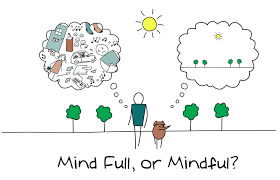
MINDFULNESS – WHAT IS IT, AND HOW CAN I DO IT?
You’ve probably heard the words “mindful” or “mindfulness”, but perhaps you aren’t quite sure what this means, or how to engage in mindful behaviours.
What Is Mindfulness?
Mindfulness is simply the awareness that arises when we deliberately pay attention, non-judgmentally, to what is happening in the present moment, both externally and in our mind and body.
Crucially, this includes our thoughts. So rather than becoming all consumed by the incessant torrent of distracting and potentially stressful thoughts that flood our minds on a daily basis, we are able to step back from them and let them go.
There is a robust, and ever growing, body of research that shows mindfulness-based practices, such as Mindfulness Based Stress Reduction and Mindfulness Based Cognitive Therapy can help with everything from depression, anxiety, stress and self-esteem to chronic pain, relationship difficulties, creativity and productivity. Mindfulness can also help you to fall asleep at night and assist in moderating your food intake i.e. mindful eating, which is great for those to tend to over-indulge.
Can I Learn Mindfulness?
Absolutely! You have little mindful moments everyday already, we just want to expand on that. You can teach yourself to ‘stop and smell the roses’ more often.
The Basics of Mindfulness
You don’t need a meditation cushion or bench, or any sort of special equipment to access your mindfulness skills—but you do need to set aside some time and space.
Observe the present moment as it is. The aim of mindfulness is not quieting the mind, or attempting to achieve a state of eternal calm. The goal is simple: we’re aiming to pay attention to the present moment, without judgement. Easier said than done, we know.
Let your judgments roll by. When we notice judgements arise during our practice, we can make a mental note of them, and let them pass.
Return to observing the present moment as it is. Our minds often get carried away in thought. That’s why mindfulness is the practice of returning, again and again, to the present moment.
Be kind to your wandering mind. Don’t judge yourself for whatever thoughts crop up, just practice recognizing when your mind has wandered off, and gently bring it back.
Mindful Sleep Exercise – Body scan relaxation exercise
The body scan technique relies on getting your mind to focus on different parts of your body. There are different methods, and one that I’ve found effective is to imagine taking your mind on a trip around your body.
Use the script below, or perhaps listen to The Relaxation Podcast by Professor Colin Espie from the University of Oxford. With a calming voice, he talks you through a simple muscle relaxation exercise step by step.
Lie down and get yourself comfortable. Imagine your mind leaving your head, and travelling through your body to one of your feet. How does your foot feel? Is it relaxed, tense or sore? Is it hot or cold? Don’t make any judgments on how it feels – simply scan and observe how you feel.
Imagine your toe and foot muscles tightening, and relaxing again.
Then take your mind up to your calf, knee and thigh.
Stop in each body part to repeat the scanning, muscle tensing and relaxing.
Repeat the exercise with your other leg.
Move to a hand and work your way up both arms.
Scan, tense and relax your back, stomach, chest, shoulders and face.
You can either imagine your muscles tensing and relaxing, or physically tense and relax them – do what feels best.
You’ll know it’s starting to work when your limbs begin to feel heavy and you’re happy to sink comfortably into your mattress.
You might find your mind wanders at times. Acknowledge any thoughts that arise in a positive way, but bring your mind gently back to the exercise.
Mindful Eating Exercise: The Raisin Exercise (this is a classic introduction to mindful eating!)
You can follow the written script below, or, even better, get a raisin or some other bite-sized food you enjoy, and head here for an audio recording: http://www.mbsrtraining.com/mindfully-eating-a-raisin-exercise/
Place a few raisins in your hand. If you don’t have raisins, any food will do. Imagine that you have just come to Earth from a distant planet without such food.
Now, with this food in hand, you can begin to explore it with all of your senses.
Focus on one of the objects as if you’ve never seen anything like it before. Focus on seeing this object. Scan it, exploring every part of it, as if you’ve never seen such a thing before. Turn it around with your fingers and notice what colour it is.
Notice the folds and where the surface reflects light or becomes darker.
Next, explore the texture, feeling any softness, hardness, coarseness, or smoothness.
While you’re doing this, if thoughts arise such as “Why am I doing this weird exercise?” “How will this ever help me?” or “I hate these objects,” then just see if you can acknowledge these thoughts, let them be, and then bring your awareness back to the object.
Take the object beneath your nose and carefully notice the smell of it.
Bring the object to one ear, squeeze it, roll it around, and hear if there is any sound coming from it.
Begin to slowly take the object to your mouth, noticing how the arm knows exactly where to go and perhaps becoming aware of your mouth watering consistency as you chew.
When you feel ready to swallow, consciously notice the intention to swallow, then see if you can notice the sensations of swallowing the raisin, sensing it moving down to your throat and into your oesophagus on its way to your stomach.
Take a moment to congratulate yourself for taking this time to experience mindful eating.
Keen to learn more? Here are some articles you may be interested in:
Why sleep and Mindfulness go hand in hand: https://www.huffingtonpost.co.uk/entry/why-sleep-mindfulness-and-wellness-go-hand-in-hand_uk_57e8f98be4b004d4d86343bd
Mindfulness For Sleep: https://www.thehealthy.com/sleep/mindfulness-for-sleep/
The Raisin Exercise for Mindful Eating: http://www.mbsrtraining.com/mindfully-eating-a-raisin-exercise/
6 Ways to Practice Mindful Eating: https://www.mindful.org/6-ways-practice-mindful-eating/

